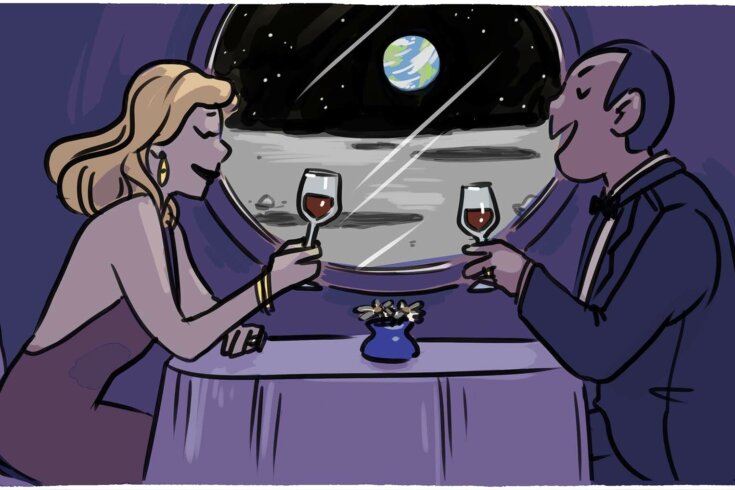It’s been said that, within our lifetime, booking a trip to outer space could be as easy as buying a plane ticket to Europe. Elon Musk’s SpaceX is already advertising orbital flights for the ultrarich. The next frontier, for some entrepreneurs, is the moon. It’s been over fifty years since humans set foot on its surface, but a Jetsons-esque world of lunar hotels, commercial space walks, and rover rides might not be so far away. We asked Chris Lewicki, a former NASA engineer whose company, gravityLab, tests how human activities would function off planet, what’s next for space tourism.
What can tourists actually do when they get to space?
I see two types of space tourism emerging. The first will be more focused on adventure, not dissimilar to climbing Everest. It’s going to be more of a challenge: cramped quarters, limited supplies, bad food. The other type will be more of a luxury approach. Space stations that orbit Earth are roomier and can be built with better viewpoints and amenities—not to mention a way for people to wash their underwear during their trip.
What kind of technology is needed to make the moon habitable—or at least visitable?
Blue Origin has figured out how to extract oxygen from lunar regolith, or moon dust. This material contains iron, silicon, and aluminum. With enough heat, you can melt down the regolith, then use an electric current to break down those molecules into atoms, separating them from the oxygen they’re bound to. The result isn’t only air we could use to breathe but also silicon that can be converted into energy—since solar cells use it as a semiconductor.
We haven’t yet figured out the best way to grow food in space. There was an experiment last year where scientists grew plants in actual lunar soil collected on some of the Apollo missions. Unsurprisingly, the result wasn’t great. NASA does have a garden on the space station,1 but one thing we’ve learned at gravityLab is that even though you can grow plants in these conditions using hydroponics, the lack of gravity makes water cling to the roots. They absorb the oxygen from the water but none of the hydrogen, then they suffocate.
Could we see hotels in space?
Axiom Space is working with the company that helped build the International Space Station (ISS) to engineer modules (which will include a manufacturing facility, an observatory, and a hotel) that can be connected to it. They have plans to launch the first one in 2025, followed by much larger ones in subsequent years.2 In the meantime, they’ve already been flying tourists to the ISS. So these plans aren’t happening in the future—they’re happening now.
An anonymous bidder paid $28 million (US) to fly to space with Jeff Bezos. Could this type of travel ever become accessible to the masses?
It’s affordable only for the ultrawealthy right now, but historically, that’s how sea, rail, and air travel started too.3 Space is on that same trajectory.
What would you say to people who think we shouldn’t trample all over the moon for fun?
We’ve already messed up a lot of things on Earth, so it’s fair to ask why we want to go somewhere else and risk messing that up too. But we’ve also used Earth to create beauty and intrigue, to increase our knowledge, and to do meaningful things for other humans. Space can be a continuation of that. I think we can learn from our history and create more sustainable practices. It’s not going to be perfect, but the hope is that it will be better.
1 Lettuce, Chinese cabbage, mizuna mustard, red kale, and zinnia flowers are just some of the plants that astronauts have successfully grown in space.
2 Rooms in the hotel at Axiom’s $2 billion (US) space station will feature plush padded walls and panoramic views of Earth.
3 In 1941, an average flight from Los Angeles to Boston reportedly cost $4,539.24 (US) per person.
As told to Nichole Jankowski. This interview has been edited for length and clarity.




